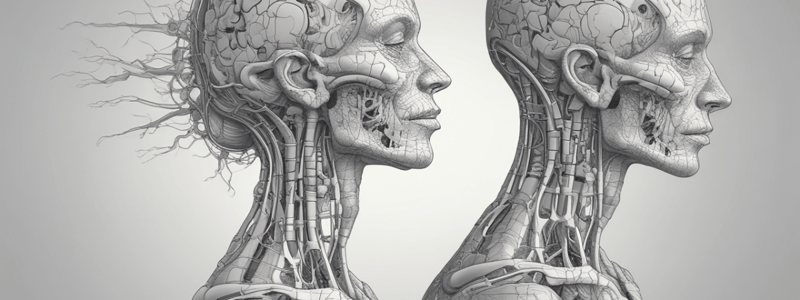Podcast
Questions and Answers
What is the most likely cause of the patient's gait disturbance?
What is the most likely cause of the patient's gait disturbance?
- Osteoarthritis
- Vitamin B12 deficiency
- Cervical spinal cord compression (correct)
- Diabetic neuropathy
What is the significance of the patient's difficulty with fine motor skills?
What is the significance of the patient's difficulty with fine motor skills?
- It is a symptom of peripheral neuropathy
- It is a side effect of diabetes medication
- It is a sign of cognitive impairment
- It is a manifestation of upper motor neuron dysfunction (correct)
What is the most likely explanation for the patient's urinary urgency and constipation?
What is the most likely explanation for the patient's urinary urgency and constipation?
- Osteoarthritis
- Spinal cord compression (correct)
- Vitamin B12 deficiency
- Diabetic autonomic neuropathy
What is the role of electromyography and nerve conduction studies in this patient's evaluation?
What is the role of electromyography and nerve conduction studies in this patient's evaluation?
What is the most appropriate next step in the evaluation of this patient?
What is the most appropriate next step in the evaluation of this patient?
What is the percentage of bilateral cases in Subdural Hematoma?
What is the percentage of bilateral cases in Subdural Hematoma?
What is the primary cause of Subdural Hematoma?
What is the primary cause of Subdural Hematoma?
What is the significance of the patient's history of falls?
What is the significance of the patient's history of falls?
What is the most common symptom of Chronic Subdural Hematoma?
What is the most common symptom of Chronic Subdural Hematoma?
What is the recommended treatment for patients with Chronic Subdural Hematoma who are asymptomatic?
What is the recommended treatment for patients with Chronic Subdural Hematoma who are asymptomatic?
What is the age range when Multiple Sclerosis is most common?
What is the age range when Multiple Sclerosis is most common?
What is the approximate cost of Multiple Sclerosis per patient per year?
What is the approximate cost of Multiple Sclerosis per patient per year?
What is the prevalence of Multiple Sclerosis worldwide?
What is the prevalence of Multiple Sclerosis worldwide?
What is the ratio of Multiple Sclerosis cases in women to men?
What is the ratio of Multiple Sclerosis cases in women to men?
What percentage of patients with myasthenia gravis experience spontaneous improvement before steroids?
What percentage of patients with myasthenia gravis experience spontaneous improvement before steroids?
At what stage of the disease does muscle atrophy typically occur?
At what stage of the disease does muscle atrophy typically occur?
What percentage of patients with myasthenia gravis experience severe exacerbation or MG crisis within the first year?
What percentage of patients with myasthenia gravis experience severe exacerbation or MG crisis within the first year?
What is the most common age of onset for myasthenia gravis in women?
What is the most common age of onset for myasthenia gravis in women?
What is the typical pattern of weakness in myasthenia gravis?
What is the typical pattern of weakness in myasthenia gravis?
What percentage of patients with myasthenia gravis develop generalized disease within the first two years of ocular symptoms?
What percentage of patients with myasthenia gravis develop generalized disease within the first two years of ocular symptoms?
What is the initial symptom in approximately 17% of patients with myasthenia gravis?
What is the initial symptom in approximately 17% of patients with myasthenia gravis?
What percentage of patients with myasthenia gravis reach maximum severity within the first year?
What percentage of patients with myasthenia gravis reach maximum severity within the first year?
Which of the following conditions can trigger myasthenia gravis?
Which of the following conditions can trigger myasthenia gravis?
What is the purpose of giving Edrophonium chloride (Tensilon) IV in the diagnosis of myasthenia gravis?
What is the purpose of giving Edrophonium chloride (Tensilon) IV in the diagnosis of myasthenia gravis?
What is the main goal of collaborative treatment in myasthenia gravis?
What is the main goal of collaborative treatment in myasthenia gravis?
Which of the following is NOT a treatment option for myasthenia gravis?
Which of the following is NOT a treatment option for myasthenia gravis?
What is the purpose of EMG (nerve conduction) tests in the diagnosis of myasthenia gravis?
What is the purpose of EMG (nerve conduction) tests in the diagnosis of myasthenia gravis?
What is the effect of spontaneous improvement or remission in myasthenia gravis?
What is the effect of spontaneous improvement or remission in myasthenia gravis?
What is the purpose of giving High-dose IV Immune Globulin in myasthenia gravis?
What is the purpose of giving High-dose IV Immune Globulin in myasthenia gravis?
What is the benefit of thymectomy in myasthenia gravis?
What is the benefit of thymectomy in myasthenia gravis?
What is the primary goal of identifying the specific cause of musculoskeletal pain?
What is the primary goal of identifying the specific cause of musculoskeletal pain?
What is the gold standard for determining the cause of musculoskeletal pain?
What is the gold standard for determining the cause of musculoskeletal pain?
What is a potential indicator of a systemic process in an adult patient with musculoskeletal pain?
What is a potential indicator of a systemic process in an adult patient with musculoskeletal pain?
What is an important question to ask during the history-taking component of a musculoskeletal pain evaluation?
What is an important question to ask during the history-taking component of a musculoskeletal pain evaluation?
What is a key component of a thorough physical examination for investigating musculoskeletal issues?
What is a key component of a thorough physical examination for investigating musculoskeletal issues?
What is a potential characteristic of musculoskeletal pain in older adults?
What is a potential characteristic of musculoskeletal pain in older adults?
What is an important aspect of evaluating neck pain?
What is an important aspect of evaluating neck pain?
What is a key principle of evidence-based management of musculoskeletal problems?
What is a key principle of evidence-based management of musculoskeletal problems?
Flashcards are hidden until you start studying
Study Notes
Case 1
- The patient is a woman who has experienced changes in her gait over the last 6 months, now using a walker, and has fallen once a month ago on uneven pavement.
- She complains of weakness and lousiness in her legs with no pain in her lower extremities.
- Her medical history includes diabetes mellitus, osteoarthritis, and CAD.
Review of Systems
- The patient experiences increased urinary urgency and constipation.
- She has difficulty opening jars and buttoning blouses.
Physical Examination
- The patient has impaired fine motor skills in her hands.
- She exhibits bilateral hyperreflexia in her ankles and patella.
- The Romberg test is positive.
Diagnostic Evaluation
- The next appropriate evaluation for the patient would be to measure her serum vitamin B12 level.
Subdural Hematoma
- A subdural hematoma is a collection of blood between the dura and the arachnoid.
- It is usually caused by head trauma, which may be mild, especially in older adults.
- The incidence of chronic subdural hematoma increases with age.
- Symptoms may include headache, slight to severe cognitive impairment, hemiparesis, seizures, and focal neurologic signs.
- Neuroimaging shows extra-axial blood collection.
Treatment of Chronic SDH
- If the patient's condition is worsening, removal of the clot may be attempted.
- If the patient's condition is improving, clinical monitoring is appropriate, as the hematoma may shrink and disappear without surgery.
Multiple Sclerosis
- The objectives of this module are to recognize the features of MS, understand and apply diagnostic criteria, and understand symptom management and disease management pharmacologic modalities for MS.
- Prevalence: 2.5 million worldwide, 400,000 in the US, with an annual cost of $41,000 per patient.
- Incidence: 2/3 more cases in women than men, typically occurring in the 2nd or 3rd decade of life (16-40 years old).
- Diagnostic criteria include prevalence, incidence, subtype, and management.
Myasthenia Gravis
- MG occurs at any age, in both genders, and begins insidiously.
- Second and third decades are the most common age of onset in women, while seventh and eighth decades are the most common in men.
- Patients complain of specific muscle weakness, not generalized fatigue.
- Ptosis or diplopia are initial symptoms in 65% of patients.
- Oropharyngeal muscle weakness is the initial symptom in 17% of patients.
- Limb weakness is a presenting symptom in only 10% of cases.
- Severity of weakness fluctuates during the day, worsening as the day progresses, especially after prolonged use of affected muscles.
Presentation (continued)
- Before steroids, near 1/3 of patients improved spontaneously, 1/3 became worse, and 1/3 died.
- Ocular myasthenia: if progressing to generalized MG, usually does so within the first two years after onset.
- After 15 to 20 years, weakness becomes fixed—the “Burnt-Out-Stage”—with muscle atrophy.
Diagnostics
- EMG (nerve conduction) tests: demonstrate decrements of the muscle action potential due to impaired nerve-to-muscle transmission.
- Diagnosis: ANA (blood test for presence of immune molecules or acetylcholine receptor antibodies), and Tensilon IV (Edrophonium chloride).
Treatment
- Control symptoms, maintain functional ability, and prevent complications.
- Collaborative treatment goals: PT, OT, Speech, thymectomy, plasmapheresis, high-dose IV immune globulin.
- CHE inhibitors: Mestinon (Pyridostigmine bromide) is the drug of choice.
Studying That Suits You
Use AI to generate personalized quizzes and flashcards to suit your learning preferences.




